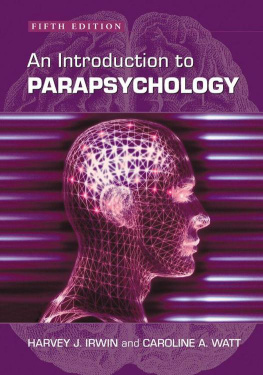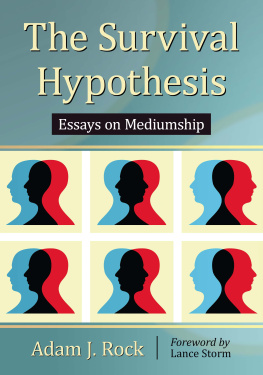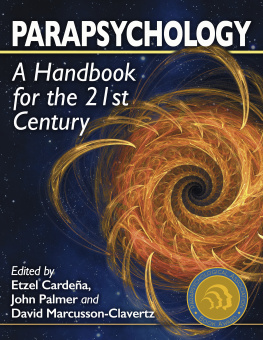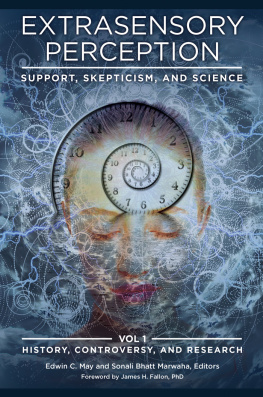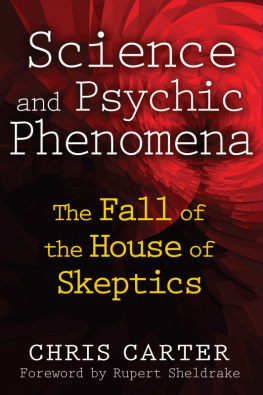ACKNOWLEDGMENTS
This book has grown out of my experiences in teaching parapsychology at the University of New England over a period of 25 years. In this context I benefited by the efforts of my students, who provided feedback on my teaching programs and who worked hard to educate me. Reliance upon earlier course notes as a framework for my book was enabled by the universitys agreement to release copyright.
The content of the book has been influenced by numerous researchers whose parapsychological work I have found to be a source of inspiration. I have endeavored to acknowledge these contributions through appropriate citations in the text, but I would like especially to record my intellectual indebtedness to the work of John Beloff, Susan Blackmore, John Palmer, Louisa E. Rhine, and Rex Stanford.
Thanks are due to the following people who graciously read and offered constructive comment upon various sections of the manuscript of the first edition: Carlos Alvarado, Alan Gauld, Ray Hyman, Jrgen Keil, Gertrude Schmeidler, Sybo Schouten, Michael Thalbourne, and Debra Weiner. Additionally, I acknowledge with gratitude the suggestions of teachers and researchers for revision of the text, some of which have been incorporated in subsequent editions: Richard Broughton, Frank Dilley, Joop Houtkooper, Stanley Krippner, Karlis Osis, Philip Stander, Rex Stanford, Jessica Utts, and Nancy Zingrone offered thoughtful advice in this regard.
In preparing this fifth edition of the book I had to face the dilemma that since my formal retirement from academia my access to the current literature in parapsychology had become more limited. The obvious solution was to solicit the assistance of a younger parapsychological researcher who is both active and eminent in the field. My first choice as co-author was Dr. Caroline A. Watt of Edinburgh University, and I was highly delighted when she accepted my invitation to revise the book. Almost all of the updated material has been contributed by Caroline, and her insightful input has served to strengthen substantially the quality of this introduction to parapsychology. It is with unqualified gratitude that I thank Caroline for her expertise, diligence, tenacity and unwavering good humor in completing the new edition.
Cases of out-of-body experience from my book Flight of Mind are quoted in Chapter 12 by permission of the publisher, Scarecrow Press. The quotation in Chapter 16 from an article in the Applied Psi Newsletter by Mishlove and Kautz (1982) is made by courtesy of the authors and the publisher, the Center for Applied Intuition.
Eric Eisenbud (on behalf of the late Jule Eisenbud), Stanley Krippner, William Roll, Helmut Schmidt, Ian Stevenson, and Charles Tart provided photographs for reproduction in the book: their generosity here is greatly appreciated. Other figures were supplied by the Rhine Research Center (RRC) and by the Mary Evans Picture Library (MEPL). The source of each figure is given in the text. The technical expertise of the University of New Englands Media Resources Unit in various photographic tasks and of Ivan Thornton in preparing the line drawings is acknowledged with thanks.
H. J. Irwin
University of New England
Armidale, Australia
September 2006
Harvey Irwin generously invited me to join him as co-author in preparing this updated edition of An Introduction to Parapsychology . Throughout our collaboration, Harvey has been unfailingly rapid in response, gracious in accepting my revisions, and kind and constructive in his feedback. Harvey, it has been a joy working with you. Throughout the process I enjoyed the support of my partner and colleague, Professor Richard Wiseman, who has the rare ability to both make me laugh and think. Thank you, Richard.
Finally, I would like to acknowledge my sorely-missed colleague and mentor, Professor Robert Morris. Bob was Koestler Professor of Parapsychology at the University of Edinburgh from 1985 until his sudden death in 2004, and was responsible for my entering parapsychology twenty years ago. If even a little of his wisdom has rubbed off on me, how fortunate I am, and it is to him that I dedicate my efforts toward this book.
C. A. Watt
University of Edinburgh
Edinburgh, Scotland
September 2006
1
INTRODUCTION
Parapsychology is the scientific study of experiences which, if they are as they seem to be, are in principle outside the realm of human capabilities as presently conceived by conventional scientists. Thus parapsychological phenomena ostensibly indicate the operation of factors currently unknown to or unrecognized by orthodox science, popularly referred to as paranormal factors. More formally, parapsychology has been defined by its proponents as the study of apparent anomalies of behavior and experience that exist apart from currently known explanatory mechanisms that account for organism-environment and organism-organism information and influence flow (Parapsychological Association, 1989, pp. 394395). Familiar examples of such anomalous phenomena are experiences that seemingly involve extrasensory perception (ESP) and apparitions (e.g., ghosts). The objective of this book is to provide an introductory survey of parapsychologists efforts to explore the authenticity and bases of these anomalous, apparently paranormal phenomena.
As a general delineation of the scope of parapsychological research the above paragraph has several features warranting consideration. Most important is the point that in no way is there any presumption here of the existence of the paranormal, contrary to the approach of many contemporary parapsychologists who actually regard parapsychology as the study of the paranormal. Certainly people report having experiences in which it seemed to them there was, for example, some information acquired without the involvement of the recognized human senses. But when such an extrasensory experience is termed parapsychological no conclusion has necessarily been reached that there exists a paranormal process by which information can be mediated outside the individuals sensory capacities.
As far as the definition of parapsychological experiences is concerned it is purely a matter of appearances, of how an experience seems to be. A fundamental task of researchers then is to investigate the actual bases of these experiences, determining the extent to which the phenomena are explicable within the framework of accepted principles of mainstream science and if appropriate, defining the respects in which that framework should be extended in order to accommodate empirical findings on the phenomena.

